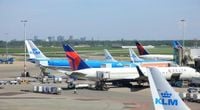A massive fire at a transformer station led to a power outage that significantly disrupted operations at London Heathrow Airport on Friday, March 21, 2025. The incident, which began the previous night, not only paralyzed one of the busiest airports in Europe but also had a ripple effect on flights at Amsterdam's Schiphol Airport.
The fire, which occurred at an electrical substation approximately two kilometers from Heathrow, forced the airport to close until at least midnight. Early on Friday, it was reported that over a thousand flights had been canceled, leaving around 200,000 passengers affected by the chaos. According to flight tracking service Flightradar24, more than 1,350 flights were scheduled to operate on the day of the incident.
As of 8:10 a.m. on Friday, Schiphol saw cancellations of at least 15 flights to and from Heathrow. By that point, the airport's website reported 11 canceled flights, with five departures and seven arrivals operating in the affected airspace. The flight route linking Heathrow and Schiphol, primarily served by KLM and British Airways, was hit hard with about 30 flights planned to travel between the two airports.
Seven flights already in the air were diverted to Schiphol as alternative landing options, which included Delta flights from major U.S. cities like Detroit, Boston, and Atlanta, as well as Cathay Pacific flights from Hong Kong. Unfortunately, Eindhoven Airport was unable to accept any diverted flights due to noise restrictions and limited available aircraft stands. A spokesperson from Eurocontrol warned that other European airports were also reporting limited diversion capacity, especially for wide-body aircraft.
KLM was among the airlines most impacted, canceling three roundtrip pairings that totaled six flights. A representative stated that affected travelers would be rebooked on flights starting Saturday, March 22. Travelers in urgent need of reaching London were advised to check for available seats on flights to nearby airports around the British capital. The Eurostar train service between Amsterdam and London also proved to be a popular alternative, although direct trains were largely sold out, with remaining indirect routes priced at a hefty 300 to 500 euros per ticket.
To cope with the unexpected demand, Eurostar added capacity by scheduling two additional trains in both directions between London and Paris, each capable of seating approximately 882 passengers. This decision was made to provide more options for passengers stranded at Heathrow. A Eurostar representative confirmed plans to provide extra services, further easing the plight of travelers affected by the flight cancellations.
The fallout from the fire at Heathrow significantly impacted rail operations across the region. In response to the chaos surrounding the airport's closure, Ryanair also announced four additional routes running between Dublin and Stansted Airport, catering to passengers desperate to find alternative travel options.
Emergency services were called to the burning substation shortly after the fire broke out, leading to the evacuation of about 150 residents from nearby homes. The substation fire prompted a coordinated response that included ten fire engines and roughly 70 firefighters who worked through the night to bring the incident under control.
Scottish and Southern Electricity Networks reported that the fire at the substation resulted in a significant power outage that left over 16,300 homes without electricity. As of late Thursday, March 20, the precise cause of the fire was still under investigation, but the destruction wreaked havoc throughout the area and the operations of London's major airport.
This event serves as a stark reminder of the vulnerability of critical infrastructure and the widespread effect it can have when failures occur. As travelers faced delays and cancellations, many were left wondering about the readiness of airports and transport services to handle such emergencies in the future.
As the day progressed, officials and airlines worked to adapt to the circumstances caused by this unpredictable disaster. It is clear that the repercussions of this fire will be felt far and wide, as those traveling between the UK and the continent seek ways to navigate the continuing chaos. The interconnected nature of European air travel means that incidents like the one at Heathrow can send shockwaves through the entire region's transportation networks, leaving passengers grappling with the consequences and airlines scrambling to manage the fallout.






